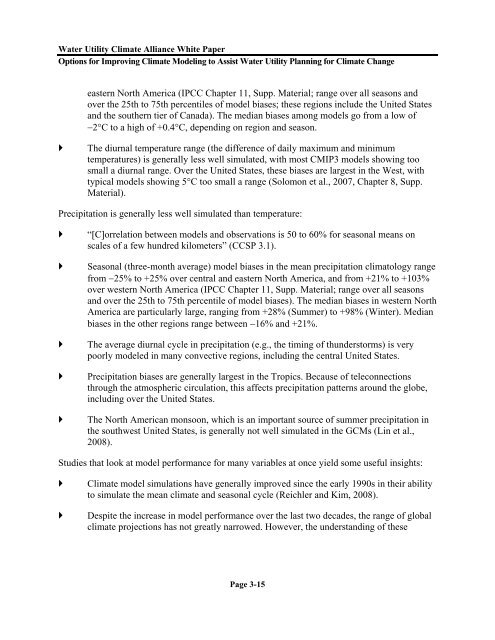Options for Improving Climate Modeling to Assist Water Utility ...
Options for Improving Climate Modeling to Assist Water Utility ...
Options for Improving Climate Modeling to Assist Water Utility ...
Create successful ePaper yourself
Turn your PDF publications into a flip-book with our unique Google optimized e-Paper software.
<strong>Water</strong> <strong>Utility</strong> <strong>Climate</strong> Alliance White Paper<br />
<strong>Options</strong> <strong>for</strong> <strong>Improving</strong> <strong>Climate</strong> <strong>Modeling</strong> <strong>to</strong> <strong>Assist</strong> <strong>Water</strong> <strong>Utility</strong> Planning <strong>for</strong> <strong>Climate</strong> Change<br />
eastern North America (IPCC Chapter 11, Supp. Material; range over all seasons and<br />
over the 25th <strong>to</strong> 75th percentiles of model biases; these regions include the United States<br />
and the southern tier of Canada). The median biases among models go from a low of<br />
2°C <strong>to</strong> a high of +0.4°C, depending on region and season.<br />
<br />
The diurnal temperature range (the difference of daily maximum and minimum<br />
temperatures) is generally less well simulated, with most CMIP3 models showing <strong>to</strong>o<br />
small a diurnal range. Over the United States, these biases are largest in the West, with<br />
typical models showing 5°C <strong>to</strong>o small a range (Solomon et al., 2007, Chapter 8, Supp.<br />
Material).<br />
Precipitation is generally less well simulated than temperature:<br />
<br />
<br />
<br />
<br />
<br />
“[C]orrelation between models and observations is 50 <strong>to</strong> 60% <strong>for</strong> seasonal means on<br />
scales of a few hundred kilometers” (CCSP 3.1).<br />
Seasonal (three-month average) model biases in the mean precipitation clima<strong>to</strong>logy range<br />
from 25% <strong>to</strong> +25% over central and eastern North America, and from +21% <strong>to</strong> +103%<br />
over western North America (IPCC Chapter 11, Supp. Material; range over all seasons<br />
and over the 25th <strong>to</strong> 75th percentile of model biases). The median biases in western North<br />
America are particularly large, ranging from +28% (Summer) <strong>to</strong> +98% (Winter). Median<br />
biases in the other regions range between 16% and +21%.<br />
The average diurnal cycle in precipitation (e.g., the timing of thunders<strong>to</strong>rms) is very<br />
poorly modeled in many convective regions, including the central United States.<br />
Precipitation biases are generally largest in the Tropics. Because of teleconnections<br />
through the atmospheric circulation, this affects precipitation patterns around the globe,<br />
including over the United States.<br />
The North American monsoon, which is an important source of summer precipitation in<br />
the southwest United States, is generally not well simulated in the GCMs (Lin et al.,<br />
2008).<br />
Studies that look at model per<strong>for</strong>mance <strong>for</strong> many variables at once yield some useful insights:<br />
<br />
<br />
<strong>Climate</strong> model simulations have generally improved since the early 1990s in their ability<br />
<strong>to</strong> simulate the mean climate and seasonal cycle (Reichler and Kim, 2008).<br />
Despite the increase in model per<strong>for</strong>mance over the last two decades, the range of global<br />
climate projections has not greatly narrowed. However, the understanding of these<br />
Page 3-15

















